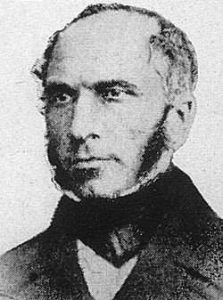4.4 Darcy’s Law
In 1856, a French engineer named Henry Darcy (Fig. 4‑4) working on water filtration systems proved that water flow through sand beds was proportional to the hydraulic gradient, the same relationship Poiseuille had discovered for laminar flow through tubes [4]. The proportionality constant, K, is called the hydraulic conductivity and is a measure of a material’s ability to transmit water. Darcy’s discovery has come to be called Darcy’s Law and can be written as:
![]()
(Eq. 4-3)
where Δψt is the difference in total water potential between two points in a saturated porous media separated by distance, L. The symbol Ks serves to clarify that we are referring to the saturated hydraulic conductivity of the soil, which differs dramatically from the hydraulic conductivity of unsaturated soil as we will soon see. Darcy noted that the hydraulic conductivity depended on the permeability of the porous media. By comparing Darcy’s Law with Poiseuille’s Law, we can also see that the hydraulic conductivity depends on the viscosity of the fluid, which itself with vary with the temperature of the fluid. Although the experiments leading to Darcy’s law used only sand, the relationship has proven to accurately describe flow in a wide array of soil types and other porous media. It has become one of the most important relationships in soil physics, hydrology, and hydrogeology. Please get a pencil and paper and watch the following two videos to learn how to use Darcy’s Law to estimate water flow through saturated soil columns. The first video shows an example of flow through a horizontal soil column, and the second video shows an example of flow through a vertical soil column. Pause the videos as necessary and work the problems for yourself to increase your understanding.

Where Poiseuille’s Law required specific information about the flow geometry, i.e. the radius of the tube, Darcy’s Law requires only an empirically determined constant, the hydraulic conductivity. This gives the Darcy’s Law the flexibility to apply to virtually any porous media, as long as the flow is laminar. But, this flexibility comes at a cost; the hydraulic conductivity can differ by several orders of magnitude from one soil type to another. The hydraulic conductivity can also differ by an order of magnitude or more from one sample to another within the same soil type. To better understand the causes of this enormous variability, let’s consider some of the primary factors which influence hydraulic conductivity and soil water flow rates. We will here be focusing, as Darcy did, on the hydraulic conductivity of saturated soil, Ks.

